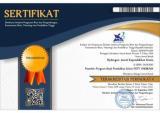Preparasi Matriks Alam Sekresi Kutu Lak Dengan Asam Adipat Pada Biokomposit Serat Rami
Abstract
In this research, preparation of natural matrix from modified flea secretion (SKL) by the addition of adipic acid as matrix in biocomposites of ramie fiber have been carried out. This research was initiated by dissolving the chunks of flea secretion using ethanol with ratio 1:2 and heated at temperature 50oC. Flea secretion has modified by the addition of adipic acid in various concentration 5%, 10%, 15%, 20%, and 25%. Viscometry technique with viscometer ostwald was used for characterizing intrinsic viscosityof natural matrix. The optimum value of intrinsic viscosity were reached at concentration 5% of adipic acid that has 77,08 mg/l viscosity. Biocomposites were made by mixing ramie fibers and natural matrix SKL which have been modified by the addition of adipic acid with optimum concentration at 60:40ratio of fibers: matrix. Biocomposites were evaluated for mechanical properties with ASTM D638 type IV standard. Biocomposite sampel was formed specimens and tested with tensile tester. Biocomposite from ramie fibers and natural matrix SKL modified by adipic acid has a tensile strength 15,14 MPa and elastic modulus was 1519,15 MPa.
Keywords
Full Text:
PDFReferences
Astika, I., Lokantara, I., & Karohika, I. M. G. (2013). Sifat Mekanis Komposit Polyester dengan Penguat Serat Sabut Kelapa. Jurnal Energi Dan Manufaktur, 6(2), 95–202.
Bahtiar, A. D. M. (2012). Aplikasi Serat Serabut Kelapa Bermatrik Sagu dan Gliserol Sebagai Pengganti Kemasan Makanan Dari Sterofoam. Jurnal Teknik Mesin, 1(1), 31–39.
Dwijaya, M. S. (2016). Pengaruh Penambahan Asam Adipat terhadap Kekuatan Tarik dan Stabilitas Termal dari Poliuretan (Institut Teknologi Sepuluh November Surabaya). https://doi.org/10.1017/CBO9781107415324.004
Faizin, K. N. (2012). Pengaruh Penambahan Borax dan Khitosan terhadap Kekuatan Tarik Biokomposit Serat Rami Bermatrik Sagu. Jurnal Teknik Mesin, 1(1), 29–38.
Goda, K., Sreekala, M. S., Malhotra, S. K., Joseph, K., & Thomas, S. (2013). Advances in polymer composites: Biocomposites-state of the art, new challenges, and opportunities. Polymer Composites, Biocomposites, 3, 1–10. https://doi.org/10.1002/9783527674220.ch1
Handayani, P. A. (2010). Polimerisasi Akrilamid Dengan Metode Mixed-Solvent Precipitation dalam Pelarut Etanol-Air. Jurnal Sains Dan Teknologi Universitas Negeri Semarang, 8(1), 69–78.
Khalil, H. P. S. A., Aprilia, N. A. S., Bhat, A. H., Jawaid, M., Paridah, M. T., & Rudi, D. (2013). A Jatropha biomass as renewable materials for biocomposites and its applications. Renewable and Sustainable Energy Reviews, 22, 667–685. https://doi.org/10.1016/j.rser.2012.12.036
Minhatul Ulya, R. A. (2012). Pengaruh Suhu Polimerisasi L-Asam Laktat Melalui Metode Ring Opening Polymerization (ROP) Terhadap Karakteristik Polylactic Acid (PLA) (Polymerization Temperature Effect of L-Lactic Acid By Rop Method on Pla Characteristics). UNESA Journal of Chemistry, 1(1), 68–74.
Mujiyono, Jamasri, Heru S.B.R, J.P., & G. S. (2010). Mechanical Properties of Ramie Fibers Reinforced Biobased Material Alternative as Natural Matrix Biocomposite. International Journal of Materials Science, 5(6), 973–4589.
Porwanto, D. A., & Johar, L. (2011). Karakterisasi komposit berpenguat serat bambu dan serat gelas sebagai alternatif bahan baku industri. Jurnal Teknik Fisika ITS, 1–16.
Raharjo, R. (2012). Pengaruh Fraksi Volume Serat Rami terhadap Kekuatan Bending Biokomposit Bermatrik Pati Sagu. Jurnal Teknik Mesin, 1(1), 31–39.
Rahman, M. B. N., & Kamiel, B. P. (2011). Pengaruh Fraksi Volume Serat terhadap Sifat-sifat Tarik Komposit Diperkuat Unidirectional Serat Tebu dengan Matrik Poliester. Jurnla Ilmiah Semesta Teknika, 14(2), 133–138.
Ranta, F. (2009). Meningkatkan pendapatan petani kutu lak melalui pemberdayaan potensi daerah. PARTNER (Buletin Pertanian Terapan), 16(1), 45–50.
Rudin, A., & Choi, P. (2012). Biopolymers. In The Elements of Polymer Scinece and Engineering (pp. 521–535). https://doi.org/10.1201/b12048
Sriwita, D., & Astuti. (2014). Pembuatan Dan Karakterisasi Sifat Mekanik Bahan Komposit Serat Daun Nenas-Polyester Ditinjau Dari Fraksi Massa Dan Orientasi Serat. Jurnal Fisika Unand, 3(1), 30–36.
Suryanto, H., Supriyanto, & Haneda, N. F. (2018). Injeksi Molase untuk Meningkatkan Pertumbuhan dan Vitalitas Tanaman Kesambi (Schleicera oleosa Merr) sebagai Inang Kutu Lak. Jurnal Penelitian Kehutanan Wallacea, 7(2), 173–181.
Tanasale, M. F. J. D. P., Telussa, I., Sekewael, S. J., & Kakerissa, L. (2016). Extraction and Characterization of Chitosan from Windu Shrimp Shell (Penaeus monodon) and Depolymerization Chitosan Process with Hydrogen Peroxide Based on Heating Temperature Variation. Ind. J. Chem. Res, 3(2), 308–316.
Wona, H., Boimau, K., & Maliwemu, E. U. K. (2015). Pengaruh Variasi Fraksi Volume Serat terhadap Kekuatan Bending dan Impak Komposit Polyester Berpenguat Serat Agave Cantula. Jurnal Teknik Mesin Undana, 02(01), 39–50.
DOI: https://doi.org/10.33394/hjkk.v7i2.1759
Refbacks
- There are currently no refbacks.

This work is licensed under a Creative Commons Attribution-ShareAlike 4.0 International License.





